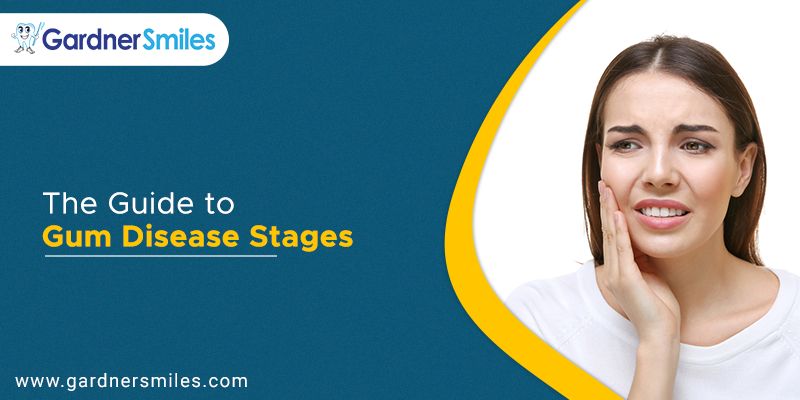Do you have any doubts regarding gum diseases and their extremity? We are here to resolve them and present you with the ultimate gum disease guide with levels of gum recession.
What Is Receding Gum Disease?
Gum disease is also known as periodontal disease. Periodontal means around the tooth. Thus, as the name suggests, periodontal disease is a set of chronic inflammatory conditions. The conditions affect not only the gums and also the jawbone. What are the 4 stages of periodontal disease?
Gingivitis is the mildest form of the disease. In which the gums are inflamed. The inflammation is basically our body’s response to bacteria that stay in the plaque around the teeth. It also means our body is trying to fight the bacteria. Most of us have it in at least some parts of our mouths.
Gingivitis can develop into periodontitis which is irreversible damage to the ligaments and teeth supporting bone. This is the later stage of the disease in which teeth may become loose, sore, or in the worst case, you can lose teeth. If you want to understand the stages of gum disease, keep reading. We will discuss the stages and their symptoms in detail later in the blog.
What are the causes behind Gum Disease?
After knowing what gum disease is, you may want to know what causes it. Gum disease is caused by bacteria in plaque which is the residue on teeth. If you don’t take care of your teeth, it may result in plaque. Also, you can end up having gum disease even if you take care of your oral health. Let’s see how.
- You have old or defective dental work done.
- You have crowded teeth.
- Your wisdom teeth are impacting other teeth.
Apart from these, there are many health issues that can change the way your body reacts to the bacteria, such as fluctuating hormones, any particular medication, smoking, excessive stress, systemic diseases such as diabetes, hereditary factors, etc.
These reasons may cause you gum disease. For identifying the disease and understanding it better, read our ultimate guide to stages of gum disease. So, let’s get started.
2 Stages Of Gum Disease
Many think that bleeding gums are the only symptom of any gum disease, and it is the only gum disease. We are here to clear the dilemma. There are two dum disease stages that we will discuss here.
- Gingivitis
- Periodontitis
Both stages have their symptoms, consequences, and treatments. Go through each of them; if you still have doubts, you can always contact us.
Gingivitis
When we understand the word Gingivitis, we need to break it down to gingiva and itis. Gingiva means the gums, and itis is a Latin-derived term for inflammation. So, gum disease – gingivitis means inflamed gums. As discussed earlier, it happens because of all the bacteria in the mouth. Bacteria and other particles result in a sticky substance called plaque. You can clean the plaque while brushing and flossing.
However, it isn’t easy to see when the mouth is full of toothpaste. If you can’t see the plaque, how will you clean it? As a result, most people have this gum disease in the mouth all the time.
If you don’t clean most plaque, your body’s immune system reacts to it, and gums become inflamed. In other words, you get gum disease. The gums look redder and puffier when inflamed. Also, they tend to bleed while you brush or floss. Additionally, when you don’t clean the plaque for a long time, it begins to harden and becomes calculus, also called tartar. It is a hardened build-up on the teeth. There are two types of calculus, or we can say there are two gingivitis stages.
- Supragingival Calculus – People with healthy saliva have supragingival calculus at the bottom of the front teeth with a creamy yellow color. You or your dentist can easily see this gingivitis stage and clean it.
- Subgingival Calculus – This is the serious gingivitis stage with the black built-up under the gum. The color back is due to the existence of blood during the gums’ inflammation. The catch here is that you cannot see it. Also, it is difficult for dentists to examine and identify this gingivitis stage.
Symptoms of Gingivitis
You may ignore the gingivitis symptoms easily, as it is painless. However, when you see gingivitis and try to clean while brushing too hard, gums may start bleeding. Now, you can no longer ignore it. Bleeding gums are early stage of receding gum and an alarming sign that you need gum disease treatment.
Periodontitis
Periodontitis is a serious gum disease that anyone gets when bacteria is accumulated on the teeth and gums. As periodontitis progresses, the bones and teeth get worse. Dentists can stop the damage if periodontitis is treated at an early stage.
Symptoms of Periodontitis
The symptoms of this gum disease depend on the stage. Here are some common ones.
- Bleeding gums while you brush or floss
- Bad breath
- Loose teeth
- Receding gums
- Red or swollen gums
- A build-up of plaque or tartar on your teeth
- Pain when chewing
- Tooth loss
4 Stages Of Periodontal Disease – Stages Of Gum Recession
What are the 4 stages of periodontal disease? Let’s understand 4 Stages Of Periodontal Disease.
Stage 1 Periodontitis: Initial
If the gum disease – gingivitis is not treated when needed, it can reach initial periodontitis or periodontitis stage 1. In this periodontiti stage, the inflamed gums are devastated. The inflammation may impact the fibres that join the roots of the teeth to the socket. The medical term for these fibres is periodontal ligament.
Symptoms of periodontitis stage 1 are similar to gingivitis. Although you will not feel any pain, your gums will be bleeding when you brush. Also, they will be more and more inflamed.
At receding gums early stages, the damages are irreversible. However, dentists can manage and guide you through this stage. The treatment for this stage is to improve the teeth cleaning process. In addition, you need to deep clean, which is called debridement. It is a process to get rid of bacteria and calculus from the gums and the roots.
Stage 2 Periodontal Disease: Moderate
If the initial stage of periodontitis is left untreated, it may end up reaching stage 2 of this gum disease which is moderate periodontitis. You may wonder what the difference is between stages 1 and 2. The amount of damage to the ligaments or joints defines the stage. The initial one has a slight impact which is mostly undetectable, whereas the moderate stage has more damage and requires gum disease treatment.
Stage 3 Periodontal Disease: Severe With Potential For Tooth Loss
If your gums reach periodontitis stage 3, you may or may not feel pain. However, your teeth may loosen up and start moving. You may also notice bad breath or bad taste. At this stage, your gums will be swollen or inflamed. Thus, your teeth may look longer than usual. You may also witness some changes in your biting due to swellings or abscesses with pus. Now, your bite can be painful in this condition.
You cannot ignore getting gum disease treatment at this stage. There are many gum disease treatment alternatives available. At this periodontitis stage, your teeth cannot be saved. Your teeth must be replaced with dentures or dental implants. You may ask the dentist to suggest the best alternative according to your gum disease.
What Is Stage 4 Periodontal Disease: Severe With Potential For Loss Of All The Teeth
This is the last and most critical periodontitis stage. Patients often have lost some of their teeth when they reach here. And the remaining teeth are also loosened up. They don’t have enough good gums or bones to support your teeth. Patients may also find it difficult to bite properly. Thus, having regular meals becomes challenging.
All stages of periodontal disease are irreversible. However, this stage is crucial, and gum disease treatment cannot be avoided. Advanced periodontal disease can result in other health issues, like diabetes. Thus, treatment is inevitable. So, as said in all periodontitis stages, gum disease cannot be reversed. However, dentists can treat and manage to give your comfort back with a gum disease treatment.
Conclusion
Many times gum disease stages are not easily identified by dentists as well. So, if you don’t understand the gum receding stages completely, fret not! You can book an appointment with Gardner Smiles and come for a regular check-up. Our dentists shall examine your oral health and let you know if you are at any gum recession stages.





